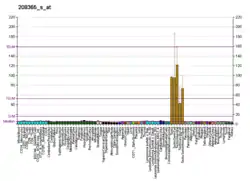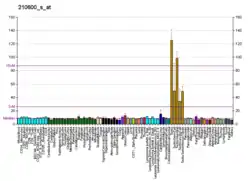| GRK4 | |||||||||||||||||||||||||||||||||||||||||||||||||||
|---|---|---|---|---|---|---|---|---|---|---|---|---|---|---|---|---|---|---|---|---|---|---|---|---|---|---|---|---|---|---|---|---|---|---|---|---|---|---|---|---|---|---|---|---|---|---|---|---|---|---|---|
| |||||||||||||||||||||||||||||||||||||||||||||||||||
| Identifiers | |||||||||||||||||||||||||||||||||||||||||||||||||||
| Aliases | GRK4, GPRK2L, GPRK4, GRK4a, IT11, G protein-coupled receptor kinase 4 | ||||||||||||||||||||||||||||||||||||||||||||||||||
| External IDs | OMIM: 137026 MGI: 95801 HomoloGene: 23158 GeneCards: GRK4 | ||||||||||||||||||||||||||||||||||||||||||||||||||
| |||||||||||||||||||||||||||||||||||||||||||||||||||
| |||||||||||||||||||||||||||||||||||||||||||||||||||
| |||||||||||||||||||||||||||||||||||||||||||||||||||
| |||||||||||||||||||||||||||||||||||||||||||||||||||
| Wikidata | |||||||||||||||||||||||||||||||||||||||||||||||||||
| |||||||||||||||||||||||||||||||||||||||||||||||||||
G protein-coupled receptor kinase 4 (GRK4) is an enzyme that is encoded by the GRK4 gene in humans.[5]
This gene encodes a member of the G protein-coupled receptor kinase subfamily of the Ser/Thr protein kinase family, and is most similar to GRK5 and GRK6.[6]
G protein-coupled receptor kinases phosphorylate activated G protein-coupled receptors, which promotes the binding of an arrestin protein to the receptor. Arrestin binding to a phosphorylated, active receptor prevents receptor stimulation of heterotrimeric G protein transducer proteins, blocking their cellular signaling and resulting in receptor desensitization. Moreover Arrestin binding to a phosphorylated, active receptor also enables receptor signaling through arrestin partner proteins. Consequently the GRK/arrestin system serves as a signaling switch for G protein-coupled receptors.[7]
GRK4 is most highly expressed in the testes, with lower amounts found in the brain, kidney and other tissues. It exists in four alternatively-spliced variants.[8]
Polymorphisms in the GRK4 gene have been linked to both genetic and acquired hypertension, partly acting through kidney dopamine receptors.[9][10]
References
- 1 2 3 GRCh38: Ensembl release 89: ENSG00000125388 - Ensembl, May 2017
- 1 2 3 GRCm38: Ensembl release 89: ENSMUSG00000052783 - Ensembl, May 2017
- ↑ "Human PubMed Reference:". National Center for Biotechnology Information, U.S. National Library of Medicine.
- ↑ "Mouse PubMed Reference:". National Center for Biotechnology Information, U.S. National Library of Medicine.
- ↑ Ambrose C, James M, Barnes G, Lin C, Bates G, Altherr M, Duyao M, Groot N, Church D, Wasmuth JJ, et al. (Jun 1993). "A novel G protein-coupled receptor kinase gene cloned from 4p16.3". Hum Mol Genet. 1 (9): 697–703. doi:10.1093/hmg/1.9.697. PMID 1338872.
- ↑ Premont RT, Inglese J, Lefkowitz RJ (1995). "Protein kinases that phosphorylate activated G protein-coupled receptors". FASEB J. 9 (2): 175–182. doi:10.1096/fasebj.9.2.7781920. PMID 7781920. S2CID 20428064.
- ↑ Gurevich VV, Gurevich EV (2019). "GPCR Signaling Regulation: The Role of GRKs and Arrestins". Front Pharmacol. 10: 125. doi:10.3389/fphar.2019.00125. PMC 6389790. PMID 30837883.
- ↑ Premont RT, Macrae AD, Stoffel RH, et al. (1996). "Characterization of the G protein-coupled receptor kinase GRK4. Identification of four splice variants". J. Biol. Chem. 271 (11): 6403–10. doi:10.1074/jbc.271.11.6403. PMID 8626439.
- ↑ Yang J, Villar VA, Jones JE, Jose PA, Zeng C (2015). "G protein-coupled receptor kinase 4: role in hypertension". Hypertension. 65 (6): 1148–1155. doi:10.1161/HYPERTENSIONAHA.115.05189. PMC 6350509. PMID 25870190.
- ↑ Zhang H, Sun ZQ, Liu SS, Yang LN (2016). "Association between GRK4 and DRD1 gene polymorphisms and hypertension: a meta-analysis". Clin Interv Aging. 11: 17–27. doi:10.2147/CIA.S94510. PMC 4694673. PMID 26730182.
Further reading
- Sallese M, Lombardi MS, De Blasi A (1994). "Two isoforms of G protein-coupled receptor kinase 4 identified by molecular cloning". Biochem. Biophys. Res. Commun. 199 (2): 848–54. doi:10.1006/bbrc.1994.1306. PMID 8135832.
- Sallese M, Mariggiò S, Collodel G, et al. (1997). "G protein-coupled receptor kinase GRK4. Molecular analysis of the four isoforms and ultrastructural localization in spermatozoa and germinal cells". J. Biol. Chem. 272 (15): 10188–95. doi:10.1074/jbc.272.15.10188. PMID 9092566.
- Lazari MF, Liu X, Nakamura K, et al. (1999). "Role of G protein-coupled receptor kinases on the agonist-induced phosphorylation and internalization of the follitropin receptor". Mol. Endocrinol. 13 (6): 866–78. doi:10.1210/mend.13.6.0289. PMID 10379886.
- Blaukat A, Pizard A, Breit A, et al. (2001). "Determination of bradykinin B2 receptor in vivo phosphorylation sites and their role in receptor function". J. Biol. Chem. 276 (44): 40431–40. doi:10.1074/jbc.M107024200. PMID 11517230.
- Watanabe H, Xu J, Bengra C, et al. (2003). "Desensitization of human renal D1 dopamine receptors by G protein-coupled receptor kinase 4". Kidney Int. 62 (3): 790–8. doi:10.1046/j.1523-1755.2002.00525.x. PMID 12164861.
- Perroy J, Adam L, Qanbar R, et al. (2003). "Phosphorylation-independent desensitization of GABAB receptor by GRK4". EMBO J. 22 (15): 3816–24. doi:10.1093/emboj/cdg383. PMC 169056. PMID 12881416.
- Speirs HJ, Katyk K, Kumar NN, et al. (2004). "Association of G-protein-coupled receptor kinase 4 haplotypes, but not HSD3B1 or PTP1B polymorphisms, with essential hypertension". J. Hypertens. 22 (5): 931–6. doi:10.1097/00004872-200405000-00014. PMID 15097232. S2CID 40225611.
- Rankin ML, Marinec PS, Cabrera DM, et al. (2006). "The D1 dopamine receptor is constitutively phosphorylated by G protein-coupled receptor kinase 4". Mol. Pharmacol. 69 (3): 759–69. doi:10.1124/mol.105.019901. PMID 16338988. S2CID 509393.
- Zhu H, Lu Y, Wang X, et al. (2006). "The G protein-coupled receptor kinase 4 gene affects blood pressure in young normotensive twins". Am. J. Hypertens. 19 (1): 61–6. doi:10.1016/j.amjhyper.2005.07.007. PMID 16461192.
- Zhu H, Lu Y, Wang X, et al. (2006). "The G protein-coupled receptor kinase 4 gene modulates stress-induced sodium excretion in black normotensive adolescents". Pediatr. Res. 60 (4): 440–2. doi:10.1203/01.pdr.0000238250.64591.44. PMID 16940246.
- Wang Y, Li B, Zhao W, et al. (2006). "Association study of G protein-coupled receptor kinase 4 gene variants with essential hypertension in northern Han Chinese". Ann. Hum. Genet. 70 (Pt 6): 778–83. doi:10.1111/j.1469-1809.2006.00278.x. PMID 17044852. S2CID 46694387.
- Wang Z, Armando I, Asico LD, et al. (2007). "The elevated blood pressure of human GRK4gamma A142V transgenic mice is not associated with increased ROS production". Am. J. Physiol. Heart Circ. Physiol. 292 (5): H2083–92. doi:10.1152/ajpheart.00944.2006. PMID 17259440. S2CID 25145956.





